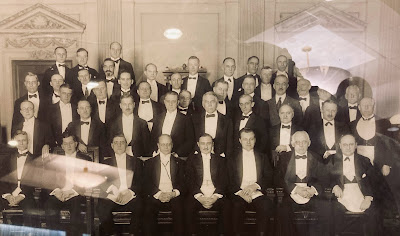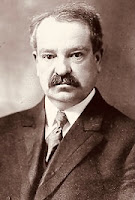 |
| time.com |
Today is Flag Day in the United States. This is a holiday, but not a federal holiday that would close government offices and financial institutions. Flag Day has been a traditional observance in American life since 1916; while that may not compute to a great span of years, we today definitely inhabit a completely different world that eschews traditions. To almost all appearances, we have become a people conditioned to indifference toward our nationality and our symbols because of some alleged guilt for which we are supposed to atone in perpetual despair.
Why observe on June 14? It was on that date in 1777 when the Second Continental Congress voted to make the Stars and Stripes our country’s flag.
It was Woodrow Wilson who issued the presidential proclamation in 1916 to “rededicate ourselves to the Nation, ‘one and inseparable,’ from which every thought that is not worthy of our fathers’ first vows of independence, liberty, and right shall be excluded, and in which we shall stand with united hearts for an America which no man can corrupt, no influence draw away from its ideals, no force divide against itself, a Nation equally distinguished among all the nations of mankind for its clear, individual conception alike of its duties and its privileges, its obligations and its rights.”
The fourteenth of June was not designated Flag Day by law until 1949, when President Truman signed House Joint Resolution 170.
Between 1916 and 1949, New York Freemasonry made its own rules which, it could be argued, were befitting of those times. Grand Master Robert H. Robinson, speaking to Grand Lodge assembled in Masonic Hall on May 2, 1922, said in reflection on the previous year:
On June 14, 1921, National Flag Day was celebrated by Masonic lodges in nearly every corner of the State, and it is our hope that this birthday of our Flag may every year be made a veritable feast day in the Craft. Masonry inculcates loyalty to State and Nation, and it is for us, as citizens of our beloved country, to keep ever alive the wisdom, the loyalty, and the patriotism of our forefathers. I quote from a memorable document on “Your Flag and Mine”:
“If anything in the world symbolizes the realization of the dream and aspirations of men, it is surely the Stars and Stripes. It has been said that young men dream dreams and old men see visions, but never before in the whole history of our race had the prophetic souls of men more surely recognized the coming of a new and better age than when Old Glory was first flung to the breeze.
“It is the symbol of the hopes, the aspirations, the struggles, the sufferings, the victories, the happiness, the progress-in short, the very lives of more than one hundred million people.
“The world has never known a banner more humble in its origin, yet more daring in its conception, and more eloquent in its appeal to the hearts and minds of men the world over. For nearly a century and a half it has flung forth a message to liberty-loving peoples of all lands, bidding them welcome to a land of opportunity, a land where there are neither kings nor czars, princes nor peasants, a land where all men are brothers with equal liberty and justice for all. And its message has been heard and answered.
“There were but 3,000,000 persons, or about one-half of the present population of New York City, in the entire United States when the flag sent forth its message over land and sea, and the civilized world laughed cynically at the ‘great experiment.’ But men’s hearts thrilled and are still thrilling at the great experiment which has become the embodiment of the greatest ideal in government the world has ever known. Men came and tasted of liberty and found that it was good.
“Today, more than 100,000,000 Americans—men, women, children—stand ready to defend their ideal with their lives, if need be, even as the little handful of patriots 140 years ago fought and died for the same ideal. Whether they be newcomers or citizens whose forefathers sought refuge on these shores, it matters not now. Americans by birth and Americans by adoption make common cause of the Flag and the ideal for which it stands.”
My honored successor, I am sure, will have a message for you this coming Flag Day couched in his own fearless and inspiring words. I cannot myself lose this opportunity of impressing upon you, men of the Grand Lodge, the nobility and far reaching effect a yearly general celebration of Flag Day would have upon the life and vitality of our Craft, and if there is nothing else in the address read to you this afternoon that invites your attention, I beg your earnest, your patriotic, and your liberty-loving loyalty to the glorification of “your flag and mine,” our glorious banner of liberty.
 |
| MW Arthur Tompkins |
Robinson’s “honored successor” was MW Arthur Tompkins (the brilliant visionary who signed my lodge’s warrant!) Several weeks later, he encouraged New York’s lodges to commemorate Flag Day. At his direction, Grand Lodge’s Bureau of Social and Educational Service provided lodges ideas for programs they could adopt, plus books, poems, and other relevant literature, including an essay of 6,000 words on the subject of the U.S. flag.
“The display of bunting by Masons throughout the State added materially to the observance of the day and patriotic exercises were conducted in many of the Lodges,” MW Townsend Scudder, chairman, said in his report on the matter.
And, in fact, on Flag Day 1921—at this very minute, actually—Sea and Field Lodge 1 hosted a Flag Day observance inside the Grand Lodge Room. Secretary William C. Prime reported to Grand Lodge how “upwards of 2,000 Master Masons from the Metropolitan District and neighborhood, at which addresses were made by Hon. Martin W. Littleton, Brother Job E. Hedges, by Rear Admiral Reynold T. Hall, Gen. Barbour, and by Bishop Wm. T. Manning. A large delegation of servicemen attended with colors, which were massed with appropriate ceremony, and the occasion was one of dignity, as befitted it, and truly memorable.”
There are many more details to share, but you get the point. My point in this edition of The Magpie Mason is I believe we have lost something. Of course our fraternity is much smaller today, so there is less talent and fewer hands to set to labor, but we unintentionally have accommodated modernity too much in our thinking. We ought to be honoring Flag Day right now. We have more than 400 lodges. Are any marking today’s holiday? I haven’t heard of any.
Our city tonight is polluted with other flags, symbols that divide people, shout for fringe cultic identities, and even encourage warfare. Our gentle Craft possesses an antidote to much of what ails society, and that the simple symbolism of a Flag Day celebration can signal to a weary and uncertain public that they are not alone—that unity with other citizens can be found.











































































